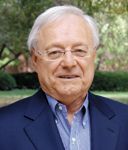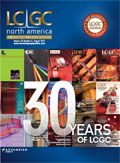Plates Versus Selectivity: An Emerging Issue With Complex Samples
LCGC North America
Smaller particles, increasingly clever ways to overcome mass transfer limitations, further reductions in plate height, shorter separation times, higher pressure, and enhanced peak capacity dominate thinking in the high performance liquid chromatography (HPLC) community today. For healthcare applications, however, we need to think differently about how to improve analytical separations.
Smaller particles, increasingly clever ways to overcome mass transfer limitations, further reductions in plate height, shorter separation times, higher pressure, and enhanced peak capacity dominate thinking in the high performance liquid chromatography (HPLC) community today. For healthcare applications, however, we need to think differently about how to improve analytical separations.
Background
Assessing wellness, diagnosing and staging disease progression, and monitoring the efficacy of drugs through the analysis of biomarkers is stimulating great excitement today; it is driven primarily by people who invest heavily in health-related technology as a form of insurance. Insurance that they can bring their badly abused bodies to the medical community and have them repaired sufficiently to provide many more years of blissful existence.
The fact that in any one test the number of biomarkers being measured is relatively small suggests that developing chromatographic analyses for them should be a simple task. As Csaba Horváth explained with the introduction of reversed-phase chromatography, organic molecules are made up of –CH– or equivalent hydrophobic groups that partition with hydrophobic surfaces. Consequently, reversed-phase chromatography is an almost universal form of LC. Most organic substances, except the most hydrophilic, bind to an octadecylsilane stationary phase. Resolving 50 biomarkers in blood samples with the current generation of reversed-phase columns would seem straightforward. We know that because reversed-phase chromatography has been used in determining blood levels of drugs for years.
The Selectivity Issue
But there are problems with reversed-phase chromatography, hydrophilic interaction liquid chromatography (HILIC), ion-exchange chromatography (IEC), and capillary electrokinetic chromatography (CEC) relative to cell lysates and blood samples that are not seen in drug monitoring. Drugs could be analyzed in blood because they were generally the most abundant analytes. We ignored all the other things; they were in the noise. That is not the case with biomarkers. They frequently have to be detected in a background of 104 –106 other components of comparable concentration that also partition with the stationary phase. The partition coefficients of many species will be very similar, or identical, to those of the biomarkers being targeted. You cannot resolve million-component mixtures with current chromatography columns having a peak capacity of a few hundred, or even a thousand. Reversed-phase chromatography and other separation modes such as HILIC, hydrophobic interaction chromatography (HIC), IEC, CEC, and capillary electrophoresis (CE) have a selectivity problem; too many types of molecules are being selected from complex mixtures for analysis. It shouldn't be necessary to select and resolve 1 million components to recognize and quantify fewer than 100 biomarkers. But how can we target small numbers of analytes that specifically?
Structure-Based Selection
Perhaps the solution to this dilemma is to target structure instead of general properties of molecules, especially in those cases where we know a set of molecules will be analyzed thousands to millions of time, as is the case with diagnostic markers. We know it is possible to select molecular species on the basis of structure because the immune system identifies foreign organisms by making protein antibodies that target structural features of the invaders. Substrate recognition, hormone reception, metabolite transport, and regulation of transcription are other functions of proteins that involve their ability to identify specific structural features of molecules, even to a stereospecific level. A single substrate, metabolite, hormone, or toxin is identified within milliseconds by protein receptors in a background of thousands of very similar species, and in all cases, without a million-step partitioning process to differentiate between species.
All of this tells us that construction of structure-based selectors is possible and widely used in nature. But most of the natural selectors don't target analytes we want to examine. We will either have to adapt what nature makes, or build our own selectors. Herein lies a great opportunity for chromatographers. The pharmaceutical industry has taught us how to make drugs and even peptides that bind to specific proteins. Similarly, we have learned from the diagnostics community that the immune system can be tricked into making antibodies against all kinds of things, including small synthetic molecules (haptens). Learning to make selectors equivalent to antibodies de novo would provide a newer and less expensive route to structure-selective stationary phases. The combinatorial chemistry community has shown that synthetic polynucleotides (aptamers) can be found and amplified that have selectivities approaching antibodies. Polypeptide phage display selectors are yet another engineered affinity matrix that has not been fully exploited as a structure-specific stationary phase. Molecularly imprinted polymers and molecularly imaged surfaces hold equal promise. And, finally, there are all the chiral phases being made today.
We also know that with immunosorbents and other forms of structure-specific selection that plate height, van Deemter plots, particle size, and all the other trappings of high performance separation systems are seldom discussed. That is because they aren't important. Beyond chiral separations, the number of peaks in structure-specific chromatography systems is often two; the first peak being substances of no value and the second being the substances you want. Large particles and poor mass transfer are not a limitation in structure-selective sorbents.
Mother Nature's Surprise
To paraphrase Heraclitus, Mother Nature is fond of hiding what she has done. One of the surprises of the Human Genome Project was that the human genome is much simpler than originally thought; not a lot more complicated than the mouse genome and too simple to do all the things the human body does, or so it seemed. That is because Mother Nature used protein families made up of isoforms to do a lot of the heavy lifting, as we are learning from proteomics. Although the number of proteins coded at the gene level is smaller than originally thought, single protein expression products are converted into families of isoforms by post-translational modifications (PTMs), many of which have different functions and can even reside in different organs. With several hundred types of PTMs to create isoforms, it can easily be seen how a single protein family can have many members. The addition of a single phosphate ester to a protein of 500 amino acids can totally change its biological function, and we have to be able to detect it in a background of thousands of other proteins.
Analytical Linkages
We see from the discussion above that structure-specific selectors are widely made in nature and have been prepared in many cases by man for the selection of protein families of very similar structure. But does that solve the problem of being able to identify disease-associated species down to the level of a single protein? Probably not. The most definitive solution will be a linked, multidimensional system — one that converts the selected family into tryptic peptide fragments, separates the fragments by reversed-phase chromatography, and detects signature fragments by tandem mass spectrometry. This strategy enables identification and quantification of several hundred biomarkers through six orthogonal dimensions of analysis within 30 min.
Conclusions
Are these concepts new? No. The immunological assay and affinity chromatography communities have known much of what is described above for years. It has just been overlooked. In the past it was acceptable to have a prostate-specific antigen (PSA) test that quantified the 50 isoforms of PSA together instead of the few that are directly associated with the disease. Now that we have a greater appreciation that specific isoforms of proteins are the best disease markers, it is necessary to respond with better analytics. The bar is now higher. Almost certainly, federal regulatory agencies will want proof that the proteins being measured in a diagnostic test are directly associated with a disease.
Based on the discussion above it is further concluded that starting with structure-specific selectors conveys a huge advantage in biomarker analysis. The central question is how that will be done. We have started with antibodies for years, but only because that was the only real option. We need better selectors. New technologies are emerging that merit examination, but someone has to be convinced to fund that work.
And last, but not least, it is concluded that the pursuit of very high selectivity phases and the chemistry that enables them will become a major issue in LC, especially in determining small numbers of analytes repeatedly in complex mixtures. A new "selectivity era" is perhaps emerging in LC.
Fred E. Regnier is a professor of chemistry at Purdue University and a member of LCGC's Editorial Advisory Board. Please send comments about this editorial to lcgcedit@advanstar.com.

Fred E. Regnier

New Method Explored for the Detection of CECs in Crops Irrigated with Contaminated Water
April 30th 2025This new study presents a validated QuEChERS–LC-MS/MS method for detecting eight persistent, mobile, and toxic substances in escarole, tomatoes, and tomato leaves irrigated with contaminated water.
University of Tasmania Researchers Explore Haloacetic Acid Determiniation in Water with capLC–MS
April 29th 2025Haloacetic acid detection has become important when analyzing drinking and swimming pool water. University of Tasmania researchers have begun applying capillary liquid chromatography as a means of detecting these substances.

.png&w=3840&q=75)

.png&w=3840&q=75)



.png&w=3840&q=75)



.png&w=3840&q=75)














